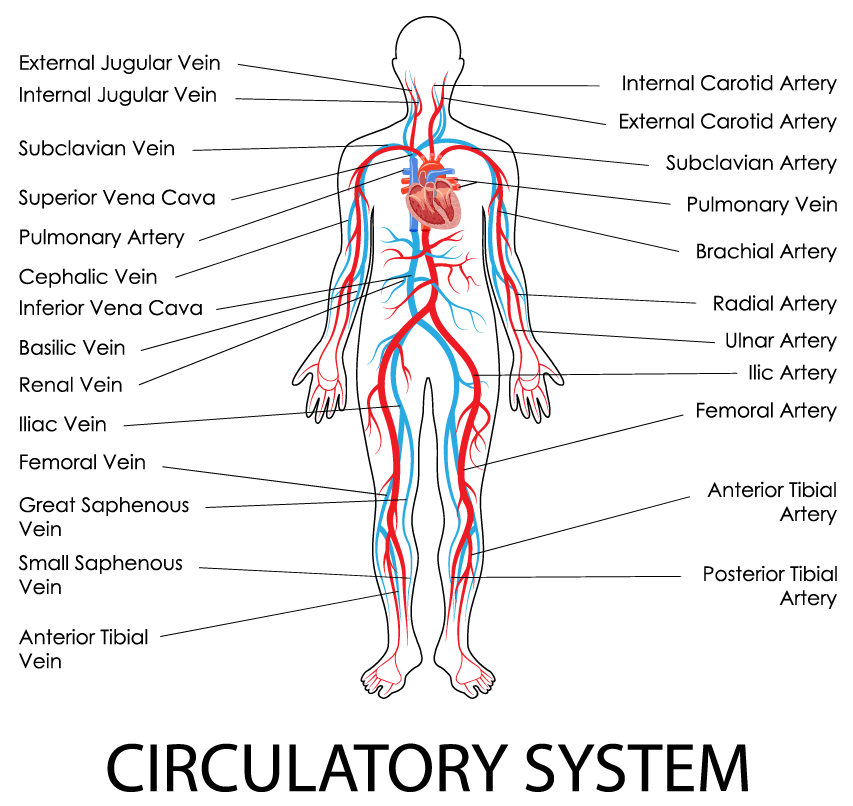Yoga for a Healthy Circulatory System
Yoga and Physiology for Optimal Health Series
by Cindy Dienhart, 500 RYT
The circulatory system is made up of blood vessels that carry blood away from and towards the heart. Arteries carry blood away from the heart and veins carry blood back to the heart. The circulatory system carries oxygen, nutrients, and hormones to cells, and removes carbon dioxide.
Unhealthy vs. Healthy
Good circulation helps prevent fatigue, l ethargy. When strong, you may feel more balanced, coordinated, integrated and focused. When weak, you may feel depleted and listless. According to Harvard Medical School , these five harmful habits are indicators of potential heart disease.
Smoking
Being inactive
Carrying too many pounds
Eating poorly
Drinking too much alcohol.
They can affect blood pressure, cholesterol, and blood sugar. All too often, the end result of these five habits is a heart attack, stroke, peripheral artery disease, valve problem, aortic aneurysm, or heart failure. And the damage they cause i sn't l imited to the cardiovascular system, but extends to the kidneys, bones, and brain.
Effects of Aging on the Heart in Men and Women
As a part of the normal aging process a number of changes occur to the cardiovascular system.
Our heart rate slows down because the time between heartbeats increases as we age. This is one of the main reasons why the heart is unable to pump out more blood during exercise when we become old.
The amount of blood the heart pumps each minute can change as we age. It decreases slightly in older women. However, it does not change in healthy older men who have no heart disease. The reason for the difference between the sexes is not fully understood.
As we age, our blood pressure falls much more on standing from the sitting position compared to when we are younger. This phenomenon is known as postural hypotension. This explains why elderly people are more likely to feel dizzy or to fall when they stand up quickly from a resting position.
7 Signs of a Healthy Heart
According to the Integra Urgent Care blog, if you plan to enjoy a long, active life, you have to keep your heart in good shape. Anything you do that involves physical movement and burns energy, from walking the dog to cycling to work, benefits your heart, according to the American Heart Association. Look for the following sure-fire signs that your heart is healthy, and continue eating right and exercising to keep your heart going stronger longer.
Heart Rate. Your heart rate should normally range between 60 to 100 beats per minute
Blood Pressure. A blood pressure reading below 120/80 i s i n the healthy range.
Energy Level. When your heart i s doing its job efficiently, you with enough energy to maintain your active lifestyle. Chronic fatigue can be a warning sign of heart problems.
Cholesterol. Healthy levels of cholesterol in your blood are vital, however, too much LDL cholesterol in your bloodstream can form blockages that impede blood flow, raising your risk of stroke and cardiovascular disease.
Quick Recovery Rate. The ability to quickly rebound to your normal heart rate after intensive exercise is another sign you have a healthy heart.
Good Oral Health
Healthy Breathing. It means your cardiovascular system is supplying your system with oxygen.
How Yoga Helps
Yoga for a healthy heart
Practicing yoga may help lower blood pressure, blood cholesterol and blood glucose levels, as well as heart rate, making it a useful lifestyle intervention.
One study has shown that blood measurements and waist circumference—a marker for heart disease—improved in middle-aged adults with metabolic syndrome who practiced yoga for three months. Another study has shown that slow-paced yoga classes twice a week reduced the frequency of atrial fibrillation episodes in patients with that condition.
In another report, patients with heart failure who went through an eight-week yoga program showed improvement in exercise capacity and quality of life. They also had lower blood levels of markers for inflammation, which contributes to heart disease.
Yoga as Exercise
“A large number of studies show that yoga benefits many aspects of cardiovascular health,” says Hugh Calkins, M.D. , director of the Cardiac Arrhythmia Service at Johns Hopkins. “There’s been a major shift in the last five years or so in the number of cardiologists and other professionals recognizing that these benefits are real.”
Yoga as a Stress Outlet
Asana, the yoga component of movement and postures, can improve circulation and either increase (vinyasa) or decrease (inversion, restorative) your heart rate.
Inversions—(heart is above head) creates increased pressure in the neck and chest slows the heart rate. Baroreceptors (manual—Energetics, page 83) are mainly responsible for the regulation of blood pressure, are stimulated by the stretch of the artery due to changes in blood pressure. Stretch of the receptors gives rise to nerve impulses, which travel to the brain.
The most sensitive baroreceptors are located in the carotid sinus (neck) and the aortic arch (in heart) which travel with the vagus nerve.
Vinyasa/dynamic movement—Improves circulation by moving fluids, oxygen and energy throughout the body with expansive movements- joints, limbs, fingers, toes.
Strengthens & tones the heart—Contraction and release of muscles and organs create efficient movement of blood.
Restorative Yoga calms the nervous system alleviating chronic stress on the heart.
Yoga for stress relief
One of yoga’s clearest benefits to the heart is its ability to relax the body and mind. Emotional stress can cause physical effects in the body, including the release of hormones like cortisol and adrenaline, which narrow your arteries and increase blood pressure. The deep breathing and mental focus of yoga can offset this stress.


